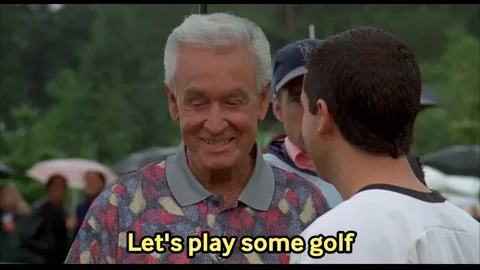Golf and B2B marketing may seem like an unlikely pair, but they share surprising similarities. Both require strategic thinking, precision, and adaptability to achieve success. So because we’ll never pass up a chance to talk about golf or marketing, let’s explore the parallels between the two, and see how the skills and strategies used in one can enhance the other.

Strategy is Key
In golf, each hole presents a unique challenge, demanding players to carefully plan their shots. A golfer must consider factors like distance, wind, and course layout before making a move. Similarly, in B2B marketing, a well-thought-out strategy is crucial. Marketers need to analyze their markets, understand their target audiences, and craft campaigns that address specific goals and challenges.
Just as a golfer plans their approach to each hole, B2B marketers develop comprehensive strategies to navigate the market landscape. This includes setting clear objectives, identifying key performance indicators (KPIs), and continuously adjusting tactics based on performance and feedback.
Precision and Accuracy
Golf is a game of precision. A slight miscalculation can send the ball off course, impacting the overall score. Similarly, B2B marketing demands accuracy. From targeting the right audience to crafting precise messaging, every element must align perfectly to achieve desired results.
In B2B marketing, precision involves using data-driven insights to fine-tune campaigns. This means leveraging analytics to understand customer behavior, segmenting audiences effectively, and personalizing messages to resonate with specific groups. Just as a golfer adjusts their swing to hit the ball accurately, B2B marketers refine their strategies to ensure their messages hit the mark.
Adaptability and Resilience
Both golf and B2B marketing require adaptability. Weather conditions can change mid-game, forcing golfers to alter their strategies on the fly. Similarly, market conditions can shift unexpectedly, requiring marketers to pivot their plans.
Successful golfers and marketers alike are resilient. They learn from their mistakes, adapt to new challenges, and keep pushing forward. In B2B marketing, this means staying agile and ready to adjust campaigns based on real-time data and market feedback. It’s about maintaining a flexible approach and being prepared to change direction when necessary.

The Long Game
Golf is often referred to as a game of patience, where success is built over 18 holes rather than a single swing. B2B marketing, too, is about playing the long game. Building brand awareness, nurturing customer relationships, and driving long-term growth require sustained effort over time.
Just as golfers focus on their overall performance throughout the course, B2B marketers must think beyond immediate results. Long-term strategies, such as content marketing, social media engagement, and customer loyalty programs, are essential for sustained success.
The Importance of Practice and Improvement
Golfers spend countless hours practicing their swing, putting, and overall game strategy. Continuous improvement is a core aspect of their success. In B2B marketing, ongoing learning and optimization are equally important. Marketers must stay updated with industry trends, learn from campaign results, and continually refine their tactics.
A commitment to improvement involves experimenting with new ideas, testing different approaches, and analyzing outcomes to identify what works best. Just as a golfer might adjust their stance or grip, B2B marketers must be willing to tweak their strategies to enhance performance continually.
Golf and B2B marketing, despite their apparent differences, share fundamental principles that drive success. Both require strategic planning, precision, adaptability, patience, and a commitment to continuous improvement. By drawing parallels between these two disciplines, B2B marketers can gain valuable insights and apply proven strategies to navigate the complexities of their marketing landscapes. Whether on the green or in the office, the key to success lies in a strategic and adaptive approach.




